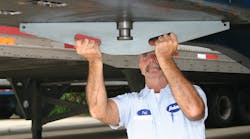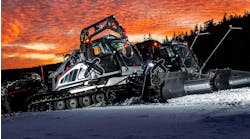Trailer upper coupler or bolster plate and kingpin inspection and maintenance is just as important as the inspection and maintenance of the fifth wheel, according to SAF-Holland (www.safholland.us), a global manufacturer of trailer and truck suspensions, fifth wheels, landing gear and coupling products.
The following procedures for proper inspection and maintenance of kingpins are recommended by SAF-Holland and based upon recommendations outlined in SAE J2228, Kingpin Wear Limits, Commercial Trailers and Semitrailers. SAE International (www.sae.org) is a global association committed to being the ultimate knowledge source for the engineering profession.
To assure proper and safe kingpin/fifth wheel coupling, kingpin inspection and maintenance should be conducted every three months or 30,000 miles, say SAF-Holland officials.
SAF-Holland company officials also advise that the specific kingpin manufacturer’s instructions for maintenance and replacement procedures be followed.
1. Using a 48” straight edge, check the upper coupler plate flatness in all directions as shown in Figure 1. Any bumps, valleys or warping will cause uneven loading of the fifth wheel, and that could result in damage to the top plate and reduce lock life.
If the flatness exceeds the specifications as shown in Figure 2, replace the trailer upper coupler plate.
2. Using a square, Holland Kingpin Gage (TF-0110) or other kingpin gage, check to see if the kingpin is bent. A bent kingpin can result from excessive coupling speed or impacting the trailer into a dock.
A bent kingpin accelerates lock wear and may interfere with proper fifth wheel locking. It also may indicate damage.
If the kingpin exceeds 1 degree from square in any direction as shown in Figure 2, replace it.
In addition to being bent, the kingpin may be pulled down in the center, deforming the bolster plate as shown in Figure 2. If this condition exists, replace the kingpin.
3. The kingpin must be the proper length to couple properly with a fifth wheel. Using a kingpin gage or square, check the length of the kingpin for proper length as shown in Figure 3.
Caution: If an add-on aftermarket lube plate is used, be sure to check the kingpin length. The kingpin must be sized to compensate for the thickness of the lube plate. Otherwise, the kingpin will be too short.
If the kingpin length is improper – as noted in the conditions below, the kingpin should be replaced.
- A long kingpin will result in excessive wear in the locks and coupling difficulty.
- A short kingpin will accelerate lock wear and may interfere with fifth wheel coupling.
4. Using a kingpin gage, check the kingpin for wear as shown in Figure 4. If the kingpin is worn 1/8” (0.125”) or more on either the 2”or 2-7/8” (2.875”) diameter in either direction, replace the kingpin.
Wear is indicated if the appropriate diameter enters the gage slot. If the gage slides into the gage slot, replace the kingpin.
5. Inspect the kingpin mounting for a secure connection to the upper coupler. A loose kingpin mounting will cause excessive chucking and rapid lock wear.
Reinstall or replace any kingpin which is not securely mounted.
6. Inspect the kingpin for any nicks, gouges, deformation or cracks which may interfere or affect the safe use of the kingpin. If any damage is present, replace the kingpin.
7. Kingpins are made from quenched and tempered alloy steel. Weld repairs of any type will affect the strength and wear resistance of the kingpin.
Additionally, arc strikes or weld craters could develop a stress riser, leading to a fatigue failure.
For these reasons, SAF-Holland warns against any weld repairs.
If any deficiencies are noted during kingpin inspection, replace the kingpin (see Figure 5)
8. If kingpin replacement is required, a replacement kingpin should be selected which is similar to the type removed, or if a different style, one which can be adequately braced.
The kingpin also must be matched to the thickness of the upper coupler to maintain the SAE dimensions.
Kingpins are manufactured in different lengths to match the thickness of the upper coupler. Improper selection will result in a kingpin that is too long or too short as indicated in Figure 6.
All photos courtesy of SAF-Holland.




